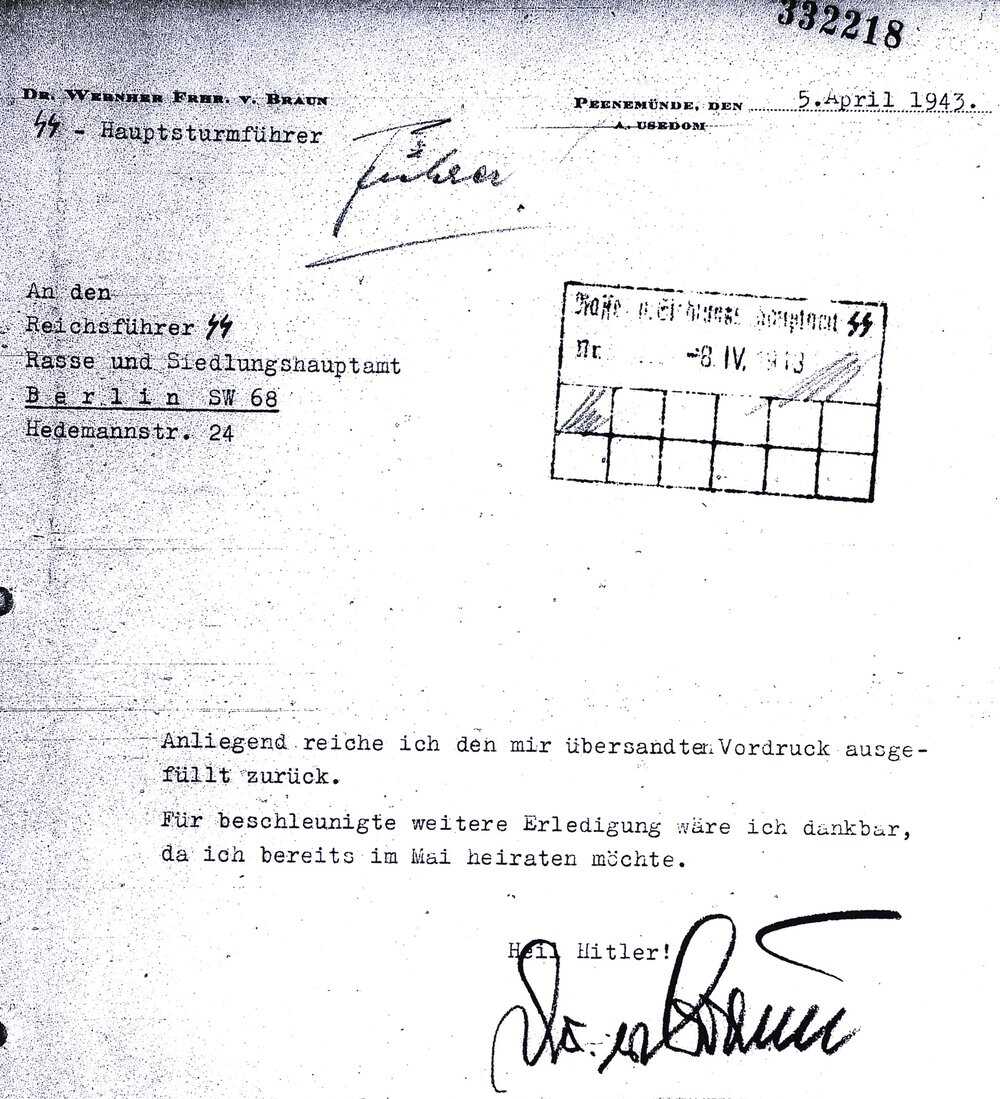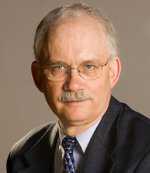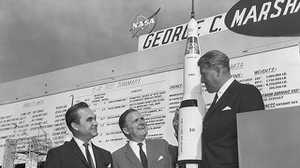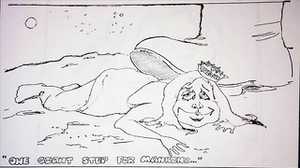Wernher von Braun and the Nazis
Wernher von Braun led NASA'S development of the Saturn V rocket that took Apollo 11 to the Moon. His Nazi record was not widely known until after his death.
By Michael J. Neufeld
![Several months after moving to Peenemünde in 1937, von Braun was told to join the National Socialist Party. In this August 1938 photo, he is wearing the swastika badge. From the archives at the U. S. Space & Rocket Center, Huntsville, AL.] CTM Von-Braun-Nazi-1938.jpg](https://staging.pbs.org/wgbh/americanexperience/media/filer_public_thumbnails/filer_public/17/6e/176ef16e-711b-4289-976b-4bf2e3490bf4/ctm_von-braun-nazi-1938.jpg__1000x800_q85_crop_subsampling-2_upscale.jpg)
Six weeks before the historic, December 1968 Apollo 8 mission to orbit the Moon, the director of NASA’s Marshall Space Flight Center in Huntsville, Alabama, Wernher von Braun, received an unpleasant surprise. A West German court asked him to testify in the trial of three former SS men from the Mittelbau-Dora concentration camp, which had supplied slave labor for the production of the V-2 ballistic missile. Von Braun had been the technical director of that project and visited the associated Mittelwerk factory a dozen times. Now the head of the center that managed the gigantic Saturn V Moon rocket, he was afraid the attendant publicity would damage his reputation and that of NASA. He tried to beg off, but in the end spoke to the judge and the court at the West German consulate in New Orleans on February 7, 1969. An excerpt from his press interview afterward appears near the beginning of Chasing the Moon, part 3. He denied any personal responsibility and put as much distance as he could between his Peenemünde rocket development center and the Mittelwerk complex.
As his long-time press person, Ed Buckbee, notes in Chasing the Moon, von Braun had received few such inquiries. He and his employer from 1945 to 1960, the U.S. Army, had effectively neutralized most of the uncomfortable questions surrounding his former service for Adolf Hitler. In autobiographical articles and press interviews, he stuck to the line that he was an apolitical scientist who only wanted to go into space. He built missiles used against Allied cities because it was his national duty in wartime. He admitted that he had been a member of the National Socialist Party but labeled it nominal and necessary to protect his career in a totalitarian society. If he mentioned concentration-camp labor, it was only obliquely, while assigning all blame to the SS. In fact, very little information about the camp story was available to the public, in part because the Army classified much of it. The military did the same with von Braun’s SS officer rank and the Nazi records of the more than one hundred associates who had come to the U.S. with him. The one thing he was willing to talk about was his March 1944 Gestapo arrest. He allegedly made drunken remarks at a party about Germany’s likely defeat and his preference for building a “spaceship.” It made him look like a victim of the Nazis, rather than a perpetrator.

Von Braun died prematurely of cancer at age 65 in 1977 and thus missed the storm that broke out seven years later. One of his closest associates, Arthur Rudolph, voluntarily went back to Germany in 1984 rather than contest a denaturalization hearing over his role as production manager in the underground plant. The Justice Department released records relating to Rudolph, von Braun and the Mittelbau-Dora camp. Von Braun’s SS membership first became widely known then, although Communist East Germany had tried in the 1960s, with little success in the West, to publicize it. Thanks to the work of investigative journalists in the 1980s and scholars in the 1990s, everything about his Nazi record, and those of associates, came out. Belatedly, many became aware of the deaths of thousands of prisoners in the V-2 program and the potential implication of von Braun, and a few key associates, in those crimes.
What do we know about his Nazi record? Born in 1912, von Braun grew up in a very conservative, nationalist aristocratic family, but became obsessed with space travel in his teens. Driven by a dream to someday lead an expedition to the Moon, he took the unusual course for a Prussian baron (as he actually was) to pursue an engineering career. In late 1932 the German Army offered to finance his doctoral dissertation if he worked in secret on liquid-propellant rocketry. Shortly thereafter, Hitler became Chancellor. Von Braun was a right-wing nationalist by upbringing but seems to have taken little interest in Nazi ideology or anti-Semitism. As money began flowing into rearmament and eventually into the rocket program, he became more enthusiastic about the regime. In 1933-34, he was a member of an SS riding group in Berlin, but National Socialist organizations were then pressing non-member students to participate in paramilitary activities. In 1937, now the technical director at age 25 of the new Army rocket center at Peenemünde on the Baltic, he received a letter asking him to join the Party. Since it required little commitment, and it might damage his career to say no, he went along.
In spring 1940, an SS man approached him with an invitation from Reichsführer-SS Heinrich Himmler to rejoin the SS as an officer. He asked his military superior, Walter Dornberger, who advised him that it was politically inconvenient for the missile program if he turned it down. Lacking any convictions that would make him say no, von Braun once again went along, although he probably could have made excuses to get out of it. By 1943 he had ascended to the rank of Sturmbannführer (major), thanks to Himmler’s appreciation for his rocket work.

In October 1942, the V-2 made its first successful flight. Hitler, motivated by a worsening war situation, soon approved production despite the missile’s technological immaturity. The problem was where to get the labor when the Eastern Front’s insatiable demands made German manpower scarce. As elsewhere in the war economy, the answer was the brutal exploitation of foreign workers and concentration-camp inmates. Thanks to Arthur Rudolph’s recommendation, an SS camp was founded at Peenemünde. In parallel, prisoners were brought to two other potential V-2 factory sites. But after a massive British air raid on Peenemünde in August 1943, Hitler and Himmler decided to concentrate manufacturing in an underground plant, leading to the founding of the Mittelwerk and the Dora camp. Von Braun had been out of the decision-making chain about camp laborers, but the new situation put him into direct contact with them and with decisions how to deploy them. He admitted to the West German court in 1969 that he had seen terrible conditions underground, although he never admitted seeing dead bodies or receiving sabotage reports that led to prisoner hangings. In summer 1944, he tried to help a French physicist prisoner, Charles Sadron, but he also talked to the commandant of Buchenwald concentration camp about transferring skilled prisoners to Mittelbau-Dora for a laboratory that he hoped Sadron would lead (Sadron refused). Some men were apparently transferred, which could further implicate him in crimes against humanity.
In the interim, the Gestapo really had arrested von Braun. He was freed by the intervention of Gen. Dornberger and Armaments Minister Albert Speer, who testified as to his indispensability for the V-2 program. The dangerous, ten-day arrest seems to have crystallized von Braun’s alienation from the Nazi regime and from Hitler, whom he had met four or five times. In my view, von Braun had sleepwalked into a Faustian bargain with the Nazis, who promised him all the money and power he wanted to build rockets, as long as they did it their way, for their purposes. He belatedly realized he was trapped, but he was still a imbued with Nazi ideas and was loyal to the Army and his superiors. Late in the war he was seen more often in SS uniform, which provided him some protection against Nazi true believers as Germany headed toward catastrophic defeat. He was lucky to be salvaged from that situation by surrendering to the U.S. Army in the Alps on May 2, 1945, along with others.
![Von Braun with his American superiors, Maj. James Hammill (left) and Col. Holger Toftoy, at Fort Bliss, outside El Paso, Texas, probably in 1945/46. Smithsonian National Air and Space Museum (NASM A-4075).] CTM-Von-Braun-Nazi-Hammill-Toftoy.jpg](https://staging.pbs.org/wgbh/americanexperience/media/filer_public_thumbnails/filer_public/ba/b4/bab4dd7d-4677-42ec-8ca9-504589d981c7/ctm-von-braun-nazi-hammill-toftoy.jpg__300x382_q85_crop_subsampling-2_upscale.jpg)
Thanks to American military interest in V-2 technology, he arrived in the U.S. in September and was quickly sent to Fort Bliss outside El Paso, Texas, to prepare for the arrival of his team. Their journey was part of a larger program to import German engineers, scientists and technicians that is best known as Project Paperclip. Due to a growing Cold War, that soon became a program of permanent immigration, which required that the dubious Nazi records of some, like von Braun, be covered up. In 1950, the Army moved his group to Huntsville as part of the consolidation and buildup of its missile work. That was where his parallel career as a space advocate took off.
Von Braun was indeed driven by a dream of spaceflight, but he was also a German nationalist who almost effortlessly became an American patriot. In both cases he had no problem building missiles for his country. He was doubtlessly an opportunist, although not one, as Tom Lehrer’s song parody would have it, completely without principles. He was, in my view, the most important rocket engineer and space promoter of the twentieth century, but his legacy will forever be tarnished by his service to a murderous regime.

Michael J. Neufeld, a Senior Curator at the National Air and Space Museum, is the author of The Rocket and the Reich (1995), Von Braun: Dreamer of Space, Engineer of War (2007), and Spaceflight: A Concise History (2018), among other works.
Published May 20, 2019.







